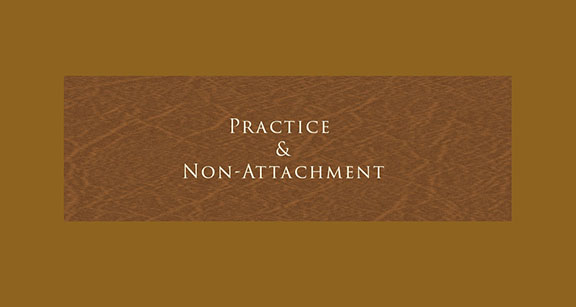 Rev. Jaganath, Integral Yoga Minister and Raja Yoga master teacher, has spent a lifetime delving into the deepest layers of meaning in Patanjali’s words within the Yoga Sutras. Our series continues with the 12th and 13th sutras of Chapter 1 in which Patanjali defines the nature of Yoga practice. Rev. Jaganath explains the conditions necessary for a truly successful Yoga practice—one that bears “its sweetest fruits.”
Rev. Jaganath, Integral Yoga Minister and Raja Yoga master teacher, has spent a lifetime delving into the deepest layers of meaning in Patanjali’s words within the Yoga Sutras. Our series continues with the 12th and 13th sutras of Chapter 1 in which Patanjali defines the nature of Yoga practice. Rev. Jaganath explains the conditions necessary for a truly successful Yoga practice—one that bears “its sweetest fruits.”
Sutra 1.12 Abhyasa vairagyabhyam tannirodhah
Swami Satchidananda translates this sutra as: These mental modifications are restrained by practice and non−attachment. He comments upon this sutra as follows: “On the positive side, you practice. On the other side, you detach yourself from the cause for these modifications. Patanjali gives both a positive and negative approach to thought control.”
The ingrained habit of mistaking the vrittis as the Self ceases by practice and nonattachment. Abhyasa implies motion, movement toward a goal. This suggests perseverance and repetition. Successful Yoga practice begins with setting clear goals, deciding on a course of action and then following through.
The heart of success in Yoga is regularity. Habits are formed through repetition. Through abhyasa good habits gradually replace harmful ones.
Nonattachment is one of the great pillars of Yoga theory and practice. It is paired with practice (as in the Bhagavad Gita, 6.35) since they harmonize, balance, and support each other. It is important not to mistake nonattachment for not caring or indifference. Nonattachment is a clear, objective, unbiased state of mind. A mind firmly established in nonattachment is not without emotion. Instead, it is clear, unbiased, and loving. Patanjali’s description of nonattachment can be found in sutras 1.15 and 1.16.
Sutra 1.13 Tatra sthitau yatnah abhyasah
I translate this sutra as follows: Of these, practice is the regular repeated effort to break free from this misidentification by cultivating steady resolve and a tranquil focused flow of awareness.
Refer to sutras 3.9 – 3.12 which discuss the development of nirodha, samadhi, and one-pointedness (ekagrata), which expand on the progressive development of a tranquil flow of attention. This reminds us that Yoga does not ask us to forcefully pin down the mind. Instead, we gain skill in guiding the mind by creating conditions in which our attention will naturally flow toward a state of one-pointedness.
Steadiness of mind is not necessarily the complete cessation of vritti activity. Instead, sthitau in this context implies that all rajasic (restless, attachment-based) and tamasic (false, negative) vrittis have quieted. The mind can now engage in one-pointed reflection on an object.
The mind, stable and free from rajasic turbulence and tamasic delusions, is prepared to experience samprajnata samadhi (See sutra 1.17).
Repetition sounds boring. The mind—usually in a state of restlessness—looks for distraction or variety in just about everything. Such a mind is not patient. It may have only rarely experienced—or forgets—the variety that is inherent in deep contemplative experiences. As we dive deeper within during meditation, we discover revelatory corners of our minds and hearts and with our clear, focused awareness, wonderful and essential aspects of life and the world around us. These deeper experiences require some effort and time, but the results are more satisfying and rewarding. They ring with meaning and nourish the mind and heart with peace, joy, and fulfillment.
This doesn’t mean that we can’t have variety in our practices, but the core of our daily routine should become stable after experimentation, study, and introspection. This is when practice really begins to yield its sweetest fruits.
About the Author:
 Reverend Jaganath Carrera is and Integral Yoga Minister and the founder/spiritual head of Yoga Life Society. He is a direct disciple of world renowned Yoga master and leader in the interfaith movement, Sri Swami Satchidananda—the founder and spiritual guide of Satchidananda Ashram–Yogaville and Integral Yoga International. Rev. Jaganath has taught at universities, prisons, Yoga centers, and interfaith programs both in the USA and abroad. He was a principal instructor of both Hatha and Raja Yoga for the Integral Yoga Teacher Training Certification Programs for over twenty years and co-wrote the training manual used for that course. He established the Integral Yoga Ministry and developed the highly regarded Integral Yoga Meditation and Raja Yoga Teacher Training Certification programs. He served for eight years as chief administrator of Satchidananda Ashram–Yogaville and founded the Integral Yoga Institute of New Brunswick, NJ. He is also a spiritual advisor and visiting lecturer on Hinduism for the One Spirit Seminary in New York City. Reverend Jaganath is the author of Inside the Yoga Sutras: A Sourcebook for the Study and Practice of Patanjali’s Yoga Sutras, published by Integral Yoga Publications. His latest book, Patanjali’s Words, is a work-in-progress.
Reverend Jaganath Carrera is and Integral Yoga Minister and the founder/spiritual head of Yoga Life Society. He is a direct disciple of world renowned Yoga master and leader in the interfaith movement, Sri Swami Satchidananda—the founder and spiritual guide of Satchidananda Ashram–Yogaville and Integral Yoga International. Rev. Jaganath has taught at universities, prisons, Yoga centers, and interfaith programs both in the USA and abroad. He was a principal instructor of both Hatha and Raja Yoga for the Integral Yoga Teacher Training Certification Programs for over twenty years and co-wrote the training manual used for that course. He established the Integral Yoga Ministry and developed the highly regarded Integral Yoga Meditation and Raja Yoga Teacher Training Certification programs. He served for eight years as chief administrator of Satchidananda Ashram–Yogaville and founded the Integral Yoga Institute of New Brunswick, NJ. He is also a spiritual advisor and visiting lecturer on Hinduism for the One Spirit Seminary in New York City. Reverend Jaganath is the author of Inside the Yoga Sutras: A Sourcebook for the Study and Practice of Patanjali’s Yoga Sutras, published by Integral Yoga Publications. His latest book, Patanjali’s Words, is a work-in-progress.

